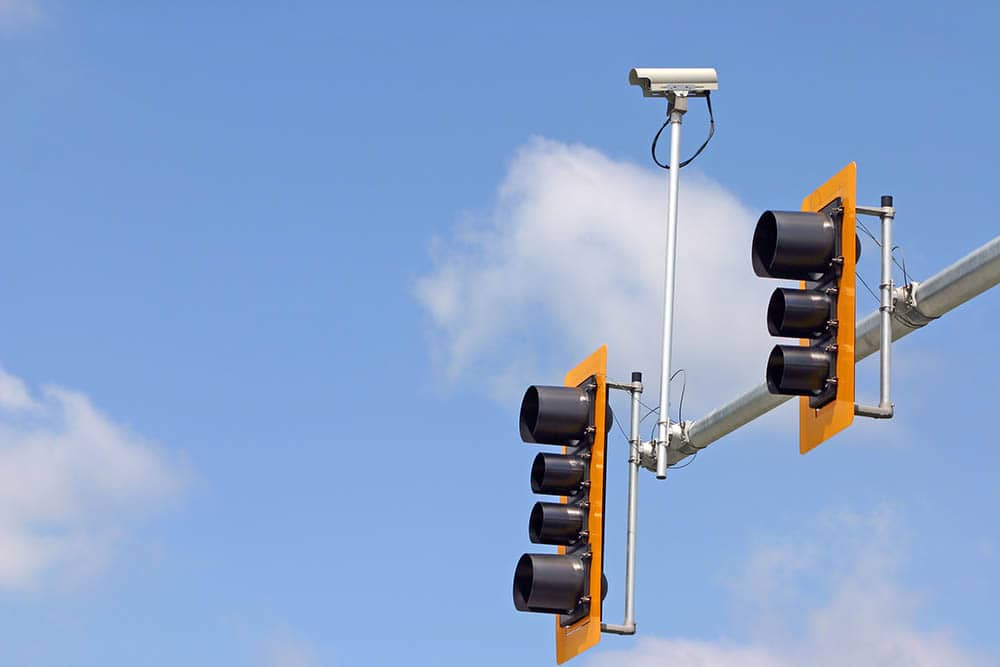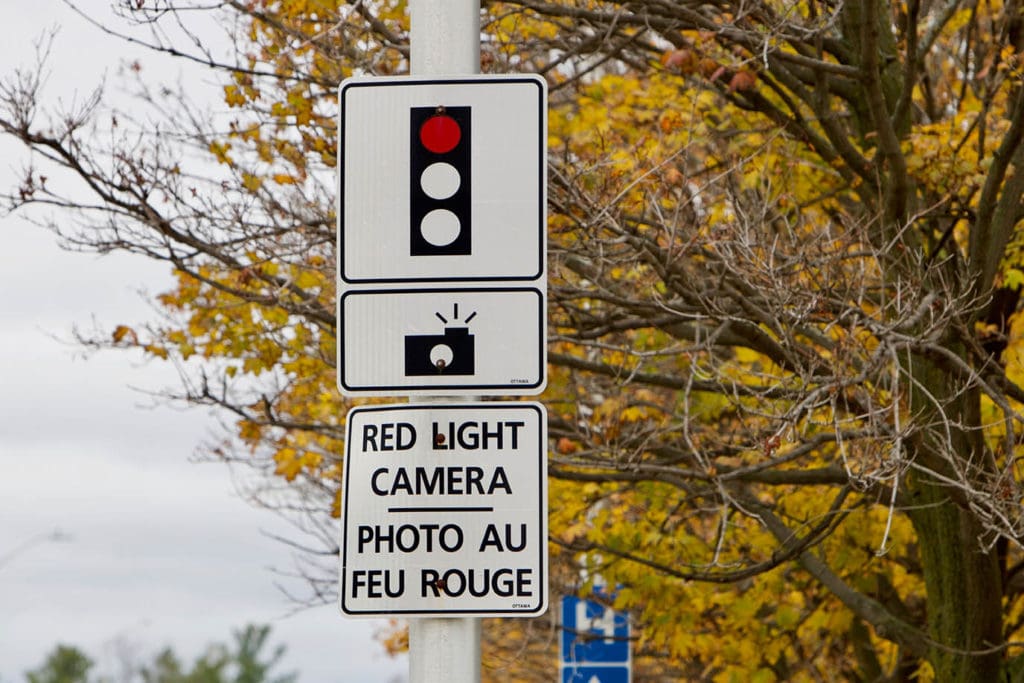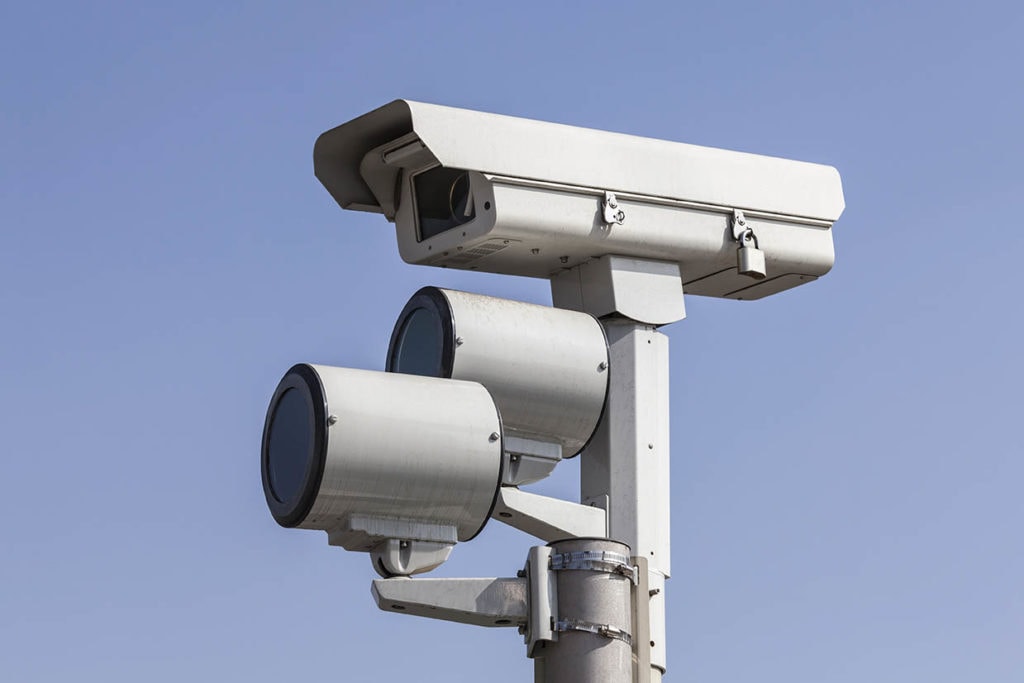17 Red Light Camera Statistics & Data – Updated In 2024
Last Updated on

Note: This article’s statistics come from third-party sources and do not represent the opinions of this website.
Nearly 40,000 people a year die in road accidents in the US, with a further 4 million suffering injuries that require hospital attention. Although accidents can occur anywhere on roads, those occurring at intersections are commonplace and they can include pedestrians, cyclists, and other road and non-road users alike. Commonly, intersection accidents happen when drivers run red lights, and automatic detection cameras were introduced in the 1990s in a bid to reduce the number of accidents and the number of people injured or killed in these accidents.
Statistics and figures do vary and can contradict one another. Still, we have gathered 16 statistics and pieces of data on red light cameras, their uses, and their effectiveness below.

The 16 Red Light Camera Statistics
- Three times as many accidents occur within 200 feet of an intersection than any other distance.
- More than 800 people per year are killed in red light accidents.
- More than 140,000 a year are injured by red light runners.
- 86% of drivers believe running a red light to be extremely dangerous.
- 52% of people believe that the police will catch red light runners.
- The first red light camera was officially used in New York City in 1993, following extensive testing.
- 400 US cities have red light cameras.
- Chicago has the most red light cameras of any major US city.
- A digital red light camera system costs $100,000 for acquisition and installation.
- There is greater public support for red light cameras than speed cameras.
- In 10 years, Chicago made more than $700 million in revenue from red-light cameras.
- Cameras reduce red light crash fatalities by 21% in large cities.
- Red light cameras could increase instances of rear-end crashes.
- Cameras reduce crash severity.
- There is no evidence that red light cameras improve public safety.
- Some intersections have seen three times as many accidents after red light cameras are installed.

Red Light Accidents
1. Three times as many accidents occur within 200 feet of an intersection than any other distance.
(LSE Phelan US Centre)
An intersection accident is one that occurs at, or near, a road intersection, although obviously not all intersections have traffic lights. According to one study, three times as many accidents occur within 200 feet, either before or after the intersection, than at any other distance to the road. This shows that, in cities at least, this is the most likely place for a road accident to occur.

2. More than 800 people per year are killed in red light accidents.
(IIHS)
Red light running occurs when a driver passes through an intersection when the traffic signal is on red. It is a motoring offense that is usually charged with a ticket, which is always accompanied by a fine and may lead to points being imposed against a license. Red light cameras were introduced in a bid to try and prevent accidents at red lights and to penalize those that jumped the lights. Red light runners cause the deaths of 800 people a year in the US, including other drivers and passengers as well as pedestrians and cyclists.
3. More than 140,000 a year are injured by red light runners.
(IIHS)
Fortunately, only a small portion of people involved in red light accidents are killed. Unfortunately, there are many injuries caused by these accidents. In fact, more than 140,000 people a year suffer injuries caused by red light runners.
4. 86% of drivers believe running a red light to be extremely dangerous.
(AAA Foundation)
An overwhelming 86% of drivers believe running a red light to be an extremely dangerous practice that is likely to cause accidents. However, that doesn’t mean that drivers aren’t willing to take risks themselves.

5. 52% of people believe that the police will catch red light runners.
(AAA Foundation)
There are several ways that police can catch red light runners, including drivers being seen by police and surveillance camera footage being used when an accident is reported. Red light cameras are one of the most common means of catching this offense. More than half of people surveyed (52%) believe that police will catch red light runners.

Cameras
6. The first red light camera was officially used in New York City in 1993, following extensive testing.
(The Newspaper)
Red light cameras have been installed for more than 30 years. The first billed use of such a device was in New York City in 1993, but this followed several years of extensive testing to determine the efficacy, effectiveness, and safety of the cameras.
7. 400 US cities have red light cameras.
(LSE Phelan US Centre)
Red light cameras are most commonly used in cities and at major intersections where accidents are most common. Cameras are commonplace in major cities like New York and Chicago, and 400 cities currently use these devices, while approximately two-thirds of major US cities have at least one installed at intersections.

8. Chicago has the most red light cameras of any major US city.
(Illinois Policy)
Cameras are commonplace in most major cities, and while New York was the first city to implement them, it is Chicago that has the honor of having the most red light cameras. In 2019, the city had 309 red light cameras. This figure was down from 2010 when there were 394 cameras but was still significantly higher than the 164 cameras in New York City, 30 cameras in Philadelphia, and just 12 cameras in Phoenix.
9. A digital red light camera system costs $100,000 for acquisition and installation.
(CDC)
A digital red light camera system isn’t cheap—it costs $100,000 for the purchase of the camera and its installation, although it is not clear exactly how much the system costs to run. As well as the cost of powering the camera, footage must be collected and stored, and software used to identify registration plates and corresponding driver details.
10. There is greater public support for red light cameras than speed cameras.
(CDC)
The red light camera is just one type of traffic enforcement camera used. The speed camera is still more common and, according to surveys, more heavily derided. The CDC reports that plans to implement camera policies are usually met with objections that such cameras are an infringement of privacy rights and are often viewed as being a money generator rather than being used for improving safety. Although red light cameras tend to enjoy positive population support, speed cameras are less popular.


The Results
11. In 10 years, Chicago made more than $700 million in revenue from red-light cameras.
(Illinois Policy)
As well as having the most cameras, Chicago also lays claim to being the city that raises the most revenue from its cameras. The city generated more than $700 million in revenue in 10 years and wants to raise this to $1 billion a year with the installation of more cameras in coming years.
12. Cameras reduce red light crash fatalities by 21% in large cities.
(IIHS 2)
Red light cameras are used most widely in large cities where traffic levels are high and there are more intersections and intersection accidents. According to some studies, the implementation of red light cameras can reduce fatalities caused by red light runners by as much as 21%.
13. Red light cameras could increase instances of rear-end crashes.
(CDC)
It is possible that red light cameras not only change the way people drive but change, rather than reduce, the types of accidents that occur on roads. While they can minimize angled or side-on collisions, there has been a more than 10% increase in the number of rear-end crashes reported at intersections with red light cameras.

14. Cameras reduce crash severity.
(CDC)
Rear-end crashes tend to have less severe consequences than side-on crashes. They occur at slower speeds and there is greater protection between drivers and passengers and the other car. Therefore, because the cameras reduce the number of severe side-on crashes but increase the number of less-severe read-end crashes, the overall severity of intersection crashes may decrease following the installation of red light cameras.
15. There is no evidence that red light cameras improve public safety.
(Scientific American)
Some independent analysis of crash statistics shows that public safety is not increased with the installation of red light cameras. One study looked at accidents around intersections in Houston between 2003 and 2014. Red light cameras were banned in 2010, which makes data comparison easier. The study suggests that there was no significant improvement in public safety after the cameras were turned off.
16. Some intersections have seen three times as many accidents after red light cameras are installed.
(National Motorists Association)
Another study suggests that the cameras may have a detrimental effect, at least on the number of accidents that occur when they are installed. A study of 32 intersections where cameras were introduced showed that there were more accidents at 20 of those intersections after the cameras were installed. The same report also highlighted instances where three times as many accidents were reported at intersections where cameras were added.

Frequently Asked Questions About Red Light Cameras
How many red light cameras are in the US?
There are no official figures for exactly how many red light cameras there are in the US or how many are currently active, but some research suggests there are at least 3,699 red light cameras. (Vox)
How long does it take to get a red light camera ticket?
When a driver is caught running a red light, the registration plate is identified and a ticket is sent through the mail to the owner’s home address. There are regulations and rules that dictate how long a state has to send a ticket, but drivers should expect the ticket to arrive within 30 to 60 days of the alleged offense being committed.
What happens if you go through a red light?
The fines associated with running a red light vary from state to state and city to city, but they range from $50 to $500, depending on whether it is a first offense or a repeat offense. The violation can also lead to points being added to a license.

Conclusion
Red light cameras were first used to penalize drivers that run red lights in New York City in 1993, although the cameras had been installed and tested for a number of years prior to this. Evidence regarding the effectiveness of the cameras in reducing accidents is somewhat contested, although public opinion of the cameras is generally quite high and certainly higher than the opinion of speed cameras.
Featured Image Credit: BIGCHEN, Shutterstock
Table of Contents
- The 16 Red Light Camera Statistics
- Red Light Accidents
- 1. Three times as many accidents occur within 200 feet of an intersection than any other distance.
- 2. More than 800 people per year are killed in red light accidents.
- 3. More than 140,000 a year are injured by red light runners.
- 4. 86% of drivers believe running a red light to be extremely dangerous.
- 5. 52% of people believe that the police will catch red light runners.
- Cameras
- 6. The first red light camera was officially used in New York City in 1993, following extensive testing.
- 7. 400 US cities have red light cameras.
- 8. Chicago has the most red light cameras of any major US city.
- 9. A digital red light camera system costs $100,000 for acquisition and installation.
- 10. There is greater public support for red light cameras than speed cameras.
- The Results
- 11. In 10 years, Chicago made more than $700 million in revenue from red-light cameras.
- 12. Cameras reduce red light crash fatalities by 21% in large cities.
- 13. Red light cameras could increase instances of rear-end crashes.
- 14. Cameras reduce crash severity.
- 15. There is no evidence that red light cameras improve public safety.
- 16. Some intersections have seen three times as many accidents after red light cameras are installed.
- Frequently Asked Questions About Red Light Cameras
- Conclusion
About the Author Robert Sparks
Robert’s obsession with all things optical started early in life, when his optician father would bring home prototypes for Robert to play with. Nowadays, Robert is dedicated to helping others find the right optics for their needs. His hobbies include astronomy, astrophysics, and model building. Originally from Newark, NJ, he resides in Santa Fe, New Mexico, where the nighttime skies are filled with glittering stars.
Related Articles:
Binocular Magnification Chart: Numbers & Distances Compared
When Were Binoculars Invented? History, Today & Future
15 Photography Industry Statistics, Trends, & Data (2024 Update)
11 Security Camera Statistics & Data – 2024 Update
18 Virtual Reality Statistics and Data – Updated in 2024
12 Glasses Industry Statistics & Data – Updated in 2024
15 Drone Statistics & Data – Updated in 2024
13 Digital Camera Sales and Statistics – Updated In 2024
